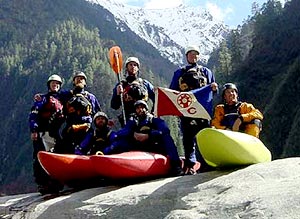We have finally made the climb out from the upper gorge—but instead of reaching Payi and heading to the Po Tsangpo confluence, we have descended to the village of Gobden and Luku. This is actually our planed take out point, but we were forced to come here due to the snow conditions between Clear Creek and Senchen La Pass. We had hoped to traverse along the top of the pass and then drop down to Rainbow and Hidden Falls. Now it seem unlikely that the kayakers will not get to go to Hidden Falls as our location adds two to three days extra trekking to the journey.
Instead we will now trek up and over to Payi, then split the group. The kayakers will head to the confluence with the Po Tsangpo and finish the whitewater descent. Ken Storm and a few others will head toward the inner gorge and explore several uncharted waterfalls that are visible on our satellite photos.
The trek over the mountains has been a long and testing one. Each kayaker carried his own boat up and over the 12,400-foot pass from around 7,200 feet. (The pass was almost 1,000 feet higher than we had expected.) This took four days and we are all hurting and having a rest day as I type. The trail from Clear Creek was tough, passing and traversing forest, until we broke the tree line and hit snow. We camped at the base of a snow gully that would be our route to the top of the pass. The ascent of the snow gully proved to be exciting and dangerous as the snow softened in the morning sun of the 18th. Andrew Sheppard broke trail, cutting snow steps to aid our ascent. Incredible views of Gyala Pelri and the flanks of Namcha Barwa were all around us as we crept up the steep snow. Amazingly no one had a serious fall, and all porters made it to the top. The kayakers were definitely wondering what the hell they were doing with kayaks on their backs at that altitude!
At the top, the porters stated that they wanted to head to Luku, not Payi, as the snow conditions were too dangerous to traverse to the Senchen La. After much discussion we started our descent to the Luku Valley. The trail started in a snow bowl, where the kayakers used their boats as sleds and the porters towed their loads in the virgin snow. Very soon we were back at tree line and stuck in a narrow gully. The snow had made things easy to a point but it was getting dangerous.
We camped not far below the snow line and rested. The next two days were total hell but character building. The trail passed through thick forest in an area that is not used too often. Every kayaker had a different system for carrying his boat, but a mix was needed to get through the forest. Sometimes the shoulder carry would be the way to go, other times the boat would have to be dragged or lowered down steep inclines. It was personally the hardest thing I have ever done—at times I was contemplating ditching the boat and exploring the waterfalls with Ken. But to have brought the boats this far into the trip…the thought of abandoning them was sickening and gave us the determination to push through.
Now we are in Gobden and working out the porter situation for the next leg of the journey. We have to trek over another 10,000-foot pass to get to Payi, then have a few days to get to the Po Tsangpo Confluence and finish our descent.
One good thing will come from passing through Luku: We should get a view of the major rapids on the way up, which will greatly aid our descent in the next week or so. We are now in the Pemako region and things are definitely different. It is a lot damper and the people are different in appearance, this is truly a journey of discovery in a rugged land.
Tsangpo Dispatch—February 21, 2002

New perk: Easily find new routes and hidden gems, upcoming running events, and more near you. Your weekly Local Running Newsletter has everything you need to lace up! .

